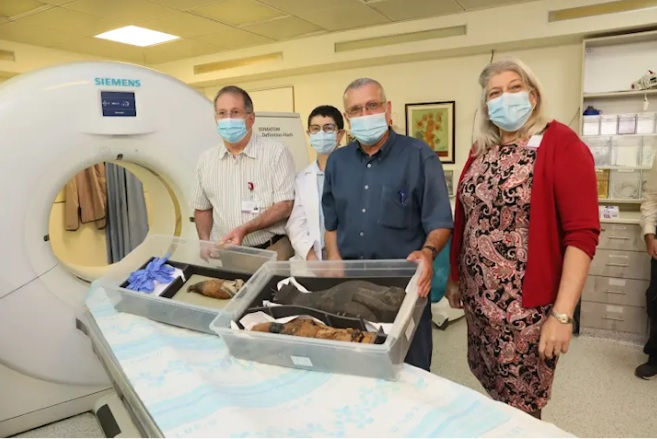Scientists first thought that beneath the wrappings of two small ancient Egyptian mummies there would be human remains, specifically hearts, but the CT scan of the mummies revealed very unusual details.
It was found that one of the mummies was tightly packed with grains and mud, while the other one had the remains of a bird, which was most probably a falcon, with a missing body part and several organs.

Dr. Marcia Javitt, the chairperson of radiology at Rambam Hospital in Haifa, Israel, and an adjunct professor of radiology at the George Washington University in Washington, D.C., who helped scan both the mummies with computed tomography (CT), revealed that the bird is missing its left leg.
Mysterious Small Mummies
Both mummies, interred in sarcophagi, have been kept for almost 50 years at Haifa Museum, in Israel. Ron Hillel, registrar, and head of collection management said that "records were not kept as diligently as they are now," so there is very little information about these mummies except one fact--they are over 2,000 years old.
As the records claimed that they contained mummified human hearts, when researchers came across these mummies, they realized the necessity to find out more about them. Hillel said after they conducted research they found that the records did not make any sense, as in ancient Egypt "the hearts were left in the body," after the death.
This is because the Egyptians used to believe that after the death, the hearts would be weighed against a feather representing "ma'at," a concept in Egypt that includes truth and justice. So, as per the experts, if the heart weighed the same or less than the feather, the deceased people would earn eternal life or else, then they would be destroyed.
Technology Unveiled the Truth
After the CT scan was conducted at Rambam Hospital the researchers came to know that an 18-inch-long human-shaped mummy, which looks like the Egyptian god of the afterlife and the dead, Osiris, contained mud and grains.
Hillel explained that in ancient Egypt, during the Osiris festival, people may have produced these artifacts by using clay or sand and mixing them with grains, and "then they would dip it in water and the grains would germinate."
As reported by LiveScience, the other bird-shaped mummy, which is around 10-inch-long, represented the Egyptian god of the Sky, Horus, who is known as the son of Isis and Osiris. Over the time the tissue of the mummy became denser, the marrow in the bones had dried out, leaving only delicate bone tubes.

Javitt and her colleagues used a dual-energy CT which helped to reveal the properties of the tissues which a usual CT scan can not do. Thanks to technology, her team has successfully identified the bird's various tissues and bones.
She noted that the bird's neck was broken, but most probably the incident might have happened after its death. Even though researchers said that the bird appears to be missing some of its organs from the abdominal section, further research is needed to come to a final conclusion, said Javitt.
However, Hillel said the Haifa Museum may make a special exhibit centered around these mummies, while he hopes to have them examined with radiocarbon to determine the real age of them.









